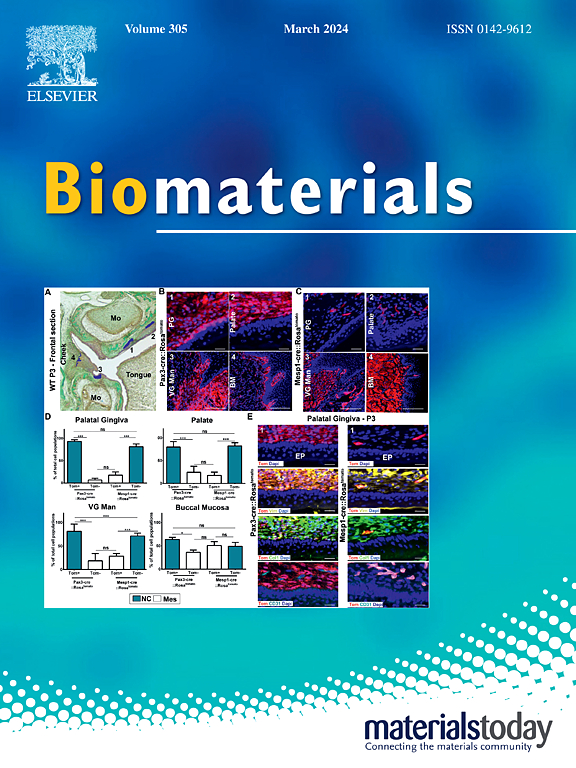Mimicking gingival endotoxin tolerance to modulate immune balance for tumor postoperative wound management
IF 12.9
1区 医学
Q1 ENGINEERING, BIOMEDICAL
引用次数: 0
Abstract
Postoperative management after tumor resection poses a significant clinical challenge as it must satisfy two demands – tumor eradication and tissue repair, which require contradictory immunological characteristics. Current treatment strategies have limitations as they usually fulfil one of the two requirements. Here, inspired by the unique mechanism of bacteria-triggered endotoxin tolerance (ET) in maintaining tissue homeostasis in the periodontal tissue, we devise a bioactive scaffold to establish an ET-mimicking immune niche in the local tissue of tumor resection. This glucomannan derivative-based electrospun scaffold (GMES) efficiently stimulates macrophages towards an ET state via a toll-like receptor-2 (TLR2)-dependent manner that, on the one hand, overexpresses pro-inflammatory factors and macrophage receptor with collagenous structure (MARCO) to suppress tumor recurrence and, on the other hand, release anti-inflammatory and pro-regenerative factors to promote wound healing. Our in vivo tests in three models of tumor recurrence, post-resection wounds and tumor metastasis show that GMES promotes healing at the tumor resection site while preventing tumor recurrence or metastasis. Our strategy represents a novel, microbial signal-inspired approach to postoperative tumor management.

模拟牙龈内毒素耐受性调节肿瘤术后伤口处理的免疫平衡
肿瘤切除后的术后处理是临床面临的重大挑战,因为它必须满足肿瘤根除和组织修复两种需求,这两种需求需要相互矛盾的免疫学特性。目前的治疗策略有局限性,因为它们通常满足两个要求中的一个。在这里,受细菌触发的内毒素耐受性(ET)维持牙周组织内稳态的独特机制的启发,我们设计了一种生物活性支架,在肿瘤切除的局部组织中建立一个模拟ET的免疫生态位。这种基于葡甘露聚糖衍生物的电旋支架(GMES)通过toll样受体-2 (TLR2)依赖的方式,有效刺激巨噬细胞进入ET状态,一方面过度表达促炎因子和巨噬细胞胶原结构受体(MARCO),抑制肿瘤复发,另一方面释放抗炎和促再生因子,促进伤口愈合。我们在肿瘤复发、术后伤口和肿瘤转移三种模型的体内试验表明,GMES促进肿瘤切除部位愈合,同时防止肿瘤复发或转移。我们的策略代表了一种新颖的,微生物信号启发的术后肿瘤管理方法。
本文章由计算机程序翻译,如有差异,请以英文原文为准。
求助全文
约1分钟内获得全文
求助全文
来源期刊

Biomaterials
工程技术-材料科学:生物材料
CiteScore
26.00
自引率
2.90%
发文量
565
审稿时长
46 days
期刊介绍:
Biomaterials is an international journal covering the science and clinical application of biomaterials. A biomaterial is now defined as a substance that has been engineered to take a form which, alone or as part of a complex system, is used to direct, by control of interactions with components of living systems, the course of any therapeutic or diagnostic procedure. It is the aim of the journal to provide a peer-reviewed forum for the publication of original papers and authoritative review and opinion papers dealing with the most important issues facing the use of biomaterials in clinical practice. The scope of the journal covers the wide range of physical, biological and chemical sciences that underpin the design of biomaterials and the clinical disciplines in which they are used. These sciences include polymer synthesis and characterization, drug and gene vector design, the biology of the host response, immunology and toxicology and self assembly at the nanoscale. Clinical applications include the therapies of medical technology and regenerative medicine in all clinical disciplines, and diagnostic systems that reply on innovative contrast and sensing agents. The journal is relevant to areas such as cancer diagnosis and therapy, implantable devices, drug delivery systems, gene vectors, bionanotechnology and tissue engineering.
 求助内容:
求助内容: 应助结果提醒方式:
应助结果提醒方式:


